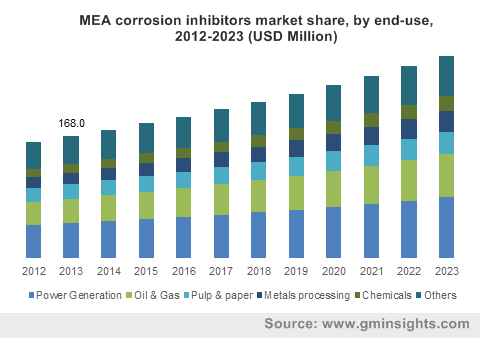Home > Chemicals & Materials > Advanced Materials > Functional Materials > Corrosion Inhibitors Market
Corrosion Inhibitors Market Size
- Report ID: GMI389
- Published Date: Apr 2016
- Report Format: PDF
Corrosion Inhibitors Market Size
Corrosion Inhibitors Market size for 2015 was close to USD 6 billion, and is anticipated to grow at over 4.9% CAGR.

Robust growth in the construction industry across the globe is analyzed to be the prime factor propelling the global corrosion inhibitors market size over the forecast timeframe. The product is widely used in coating construction materials such as steel & steel bars, bolts & nuts and metal components. The product helps in increasing the product life and durability, as its application helps the material against corrosion caused by atmospheric moisture and harsh climatic conditions. Furthermore, in 2015, the global construction investment was roughly around USD 7 trillion and shall surpass USD 13 trillion over the estimated timeframe. This trend will substantially boost the business growth by 2023
The product is an essential raw material for water treatment chemicals. Increasing water treatment chemicals demand on account to depleting clean water sources due to rapid industrialization will drive the global corrosion inhibitors market size over the projected timeframe. The overall water treatment chemicals industry is forecast to exceed USD 30 billion over the projected period. This will subsequently result in industry expansion. Furthermore, rising clean water demand from industries including electronics, chemicals and medical will further complement industry growth.
| Report Attribute | Details |
|---|---|
| Base Year: | 2015 |
| Corrosion Inhibitors Market Size in 2015: | 6 Billion (USD) |
| Forecast Period: | 2016 to 2023 |
| Forecast Period 2016 to 2023 CAGR: | 4.9% |
| 2023 Value Projection: | 8 Billion (USD) |
| Historical Data for: | 2012 to 2015 |
| No. of Pages: | 95 |
| Tables, Charts & Figures: | 92 |
| Segments covered: | Product, Application, End-use and Region |
| Growth Drivers: |
|
| Pitfalls & Challenges: |
|
The global corrosion inhibitors market size is sternly directed and regulated by environmental regulations, precisely regarding its disposal and exposure to human. For instance, increasing product usage results in disposal of harmful raw material used in the industry such as chromium, zinc and phosphorous. This is anticipated to hinder the global business growth by 2023. However, the industry players are engaged in commercialization and R&D of environment friendly products, this will create new growth prospects for the industry.
